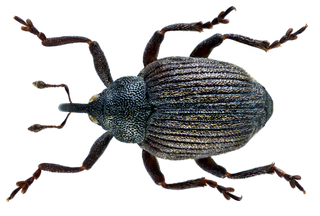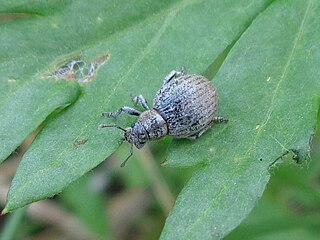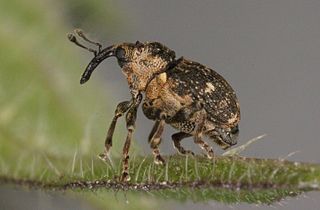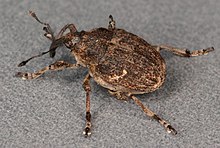
Weevils are beetles belonging to the superfamily Curculionoidea, known for their elongated snouts. They are usually small – less than 6 mm in length – and herbivorous. Approximately 97,000 species of weevils are known. They belong to several families, with most of them in the family Curculionidae. It also includes bark beetles, which while morphologically dissimilar to other weevils in lacking the distinctive snout, is a subfamily of Curculionidae. Some other beetles, although not closely related, bear the name "weevil", such as the biscuit weevil, which belongs to the family Ptinidae.

Anthonomus is a genus of weevils. This genus includes major agricultural pests such as the boll weevil, strawberry blossom weevil, and pepper weevil, as well as promising biological pest control agents such as Anthonomus santacruzi.
Hainokisaruzo is a genus of Asian weevils, established in 2005 by Hiraku Yoshitake and Enzo Colonnelli. It includes several species formerly classified as Ceutorhynchoides spp. Several further species remain to be described.

Otiorhynchus is a large genus of weevils in the family Curculionidae. Many species of the genus, particularly the black vine weevil and the strawberry root weevil, are important pests, both as larvae and as adults. Larvae feed on plant roots. Adults are flightless with fused elytra and feed at night on plant foliage. In many species of the genus at least some races are polyploid and parthenogenetic, while the rest of the races and species are diploid and bisexual. Otiorhynchus weevils, particularly O. scaber, have been a popular subject for studies of the evolution of parthenogenesis. The genus is native to the Palearctic region. However, sixteen species were inadvertently introduced to North America and have become widespread there.

Rhynchophorus, or common name palm weevils, is a genus of beetles in the weevil family, Curculionidae. Palm weevils are major pests of various trees in the family Arecaceae throughout the tropics including: coconut, Areca catechu, species of the genus Phoenix, and Metroxylon sagu. Two species are invasive pests outside their native ranges, Rhynchophorus ferrugineus and Rhynchophorus palmarum.

Ceutorhynchini is a true weevil tribe in the subfamily Baridinae.

Phytobiini is a tribe of minute seed weevils in the beetle family Curculionidae. There are about 7 genera and 18 described species in Phytobiini.

Ceutorhynchinae is a subfamily of minute seed weevils in the family of beetles known as Curculionidae. There are at least 150 genera and more than 1000 described species in Ceutorhynchinae worldwide.

Ceutorhynchus obstrictus, the cabbage seedpod weevil, is a species of snout beetles or true weevils which is widespread in Europe and lives on several types of crucifers. The adult weevils feed on the leaves, but breed in the seedpods, where the larvae destroy the seeds. It can be a harmful pest on crops like rapeseed/canola, cabbage and relatives or Brassica rapa.

Pandeleteius is a genus of broad-nosed weevils in the family Curculionidae. There are over 150 described species in Pandeleteius, distributed across the Americas. Most species in the genus were described by Anne Howden.

Auleutes is a genus of snout and bark beetles in the family Curculionidae. There are at least 30 described species in Auleutes.

Mogulones is a genus of minute seed weevils in the family of beetles known as Curculionidae. There are at least 30 described species in Mogulones.

Orchestomerus is a genus of minute seed weevils in the family of beetles known as Curculionidae. There are about 14 described species in Orchestomerus.
Rhynchus is a genus of hidden snout weevils in the family of beetles known as Curculionidae. There is at least one described species in Rhynchus, R. apiculatus.
Acanthoscelidius is a genus of minute seed weevils in the beetle family Curculionidae. There are about 14 described species in Acanthoscelidius.

Philopedon plagiatum, the marram weevil, is a species of broad-nosed weevil in the beetle family Curculionidae. It originates in Western Europe, with a distribution which includes Portugal, Spain, France, Ireland, Great Britain, Belgium, the Netherlands, Germany, Denmark, Norway, Sweden, Finland, Estonia, Latvia, Lithuania, Poland, Czech Republic, Slovakia, Russia, Ukraine, Hungary, Greece, Switzerland and Italy. It has been introduced into North America, first recorded in 1940. It is now established in the Maritime Region of Canada and the northeastern United States.

Nedyus is a genus of minute seed weevils in the beetle family Curculionidae. There are more than 50 described species in Nedyus.
Parethelcus is a genus of beetles belonging to the family Curculionidae.

Micrelus is a genus of beetles belonging to the family Curculionidae.
Neoxyonyx is a genus of beetles belonging to the family Curculionidae.















